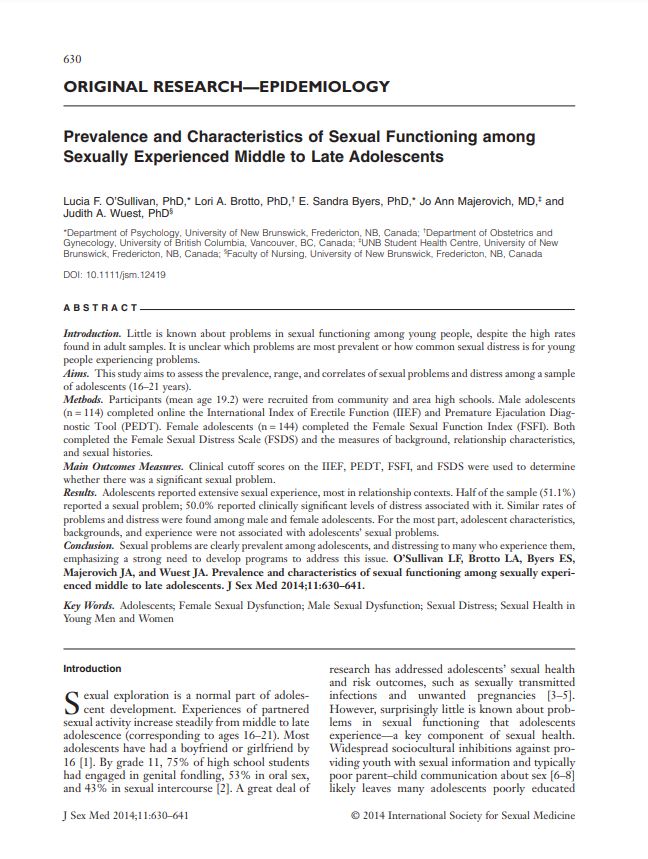Rates, Age, & Impact of Exposure to Pornography
Prevalence and Characteristics of Sexual Functioning among Sexually Experienced Middle to Late Adolescents
 Full article title: Prevalence and Characteristics of Sexual Functioning among Sexually Experienced Middle to Late Adolescents.
Full article title: Prevalence and Characteristics of Sexual Functioning among Sexually Experienced Middle to Late Adolescents.
Open Access. No.
Abstract.
Introduction. Little is known about problems in sexual functioning among young people, despite the high rates found in adult samples. It is unclear which problems are most prevalent or how common sexual distress is for young people experiencing problems. Aims. This study aims to assess the prevalence, range, and correlates of sexual problems and distress among a sample of adolescents (16–21 years). Methods. Participants (mean age 19.2) were recruited from community and area high schools. Male adolescents (n = 114) completed online the International Index of Erectile Function (IIEF) and Premature Ejaculation Diagnostic Tool (PEDT). Female adolescents (n = 144) completed the Female Sexual Function Index (FSFI). Both completed the Female Sexual Distress Scale (FSDS) and the measures of background, relationship characteristics, and sexual histories. Main Outcomes Measures. Clinical cutoff scores on the IIEF, PEDT, FSFI, and FSDS were used to determine whether there was a significant sexual problem. Results. Adolescents reported extensive sexual experience, most in relationship contexts. Half of the sample (51.1%) reported a sexual problem; 50.0% reported clinically significant levels of distress associated with it. Similar rates of problems and distress were found among male and female adolescents. For the most part, adolescent characteristics, backgrounds, and experience were not associated with adolescents’ sexual problems. Conclusion. Sexual problems are clearly prevalent among adolescents, and distressing to many who experience them, emphasizing a strong need to develop programs to address this issue.
Relevance
“More than half of the adolescent sample (51%) was characterized as having a sexual problem—a rate higher than found in adult samples. In addition, clinical levels of distress were reported by half of those who reported a sexual problem making it abundantly clear that these are problems that warrant greater research and clinical attention.”
“These data indicate that similar proportions of male and female adolescents (54% and 51%, respectively) can be described as having a problem in sexual functioning, and thus, rates do not reveal the sex disparity that so consistently characterizes studies of adults. It is unclear why we found such high rates overall, but especially the high rates among both male and female participants rather than female participants alone, as is common in the adult literature. However, because their profiles were different, the mechanisms involved likely are very different for male and female adolescents. Male and female adolescents are socialized in radically different ways…The traditional sexual script socializes men to initiate sexual interactions with women, and women to acquiesce to their male partners’ sexual needs. Women are taught to be passive sexually, whereas men are expected to pursue all sexual opportunities with women and to control their partners’ sexual decisions. Moreover, there appears to be a nearly universal sexual double standard that gives men greater sexual freedom and rights of sexual determination, yet men report considerable pressure from these expectations to perform sexually and seek ever-higher levels of
intimacy. Although not explored in detail here, such socialization may have a greater impact on adolescents than on adults.” This study did not investigate pornography use, but Culture Reframed believes, drawing on many other studies listed in this database, the adolescent use of pornography is a significant driver of sexual distress.
Citation
O’Sullivan, L.F., Brotto, L.A., Byers, E.S., Majerovich, J.A., & Wuest, J.A. (2014). Prevalence and Characteristics of Sexual Functioning among Sexually Experienced Middle to Late Adolescents. The Journal of Sexual Medicine,, 11(3), 630-641. https://doi.org/10.1111/jsm.12419.
